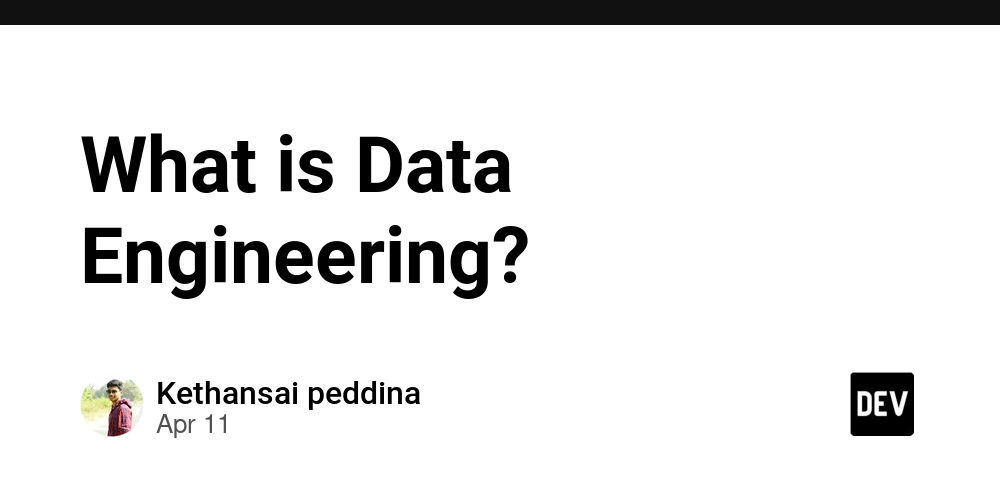What is Data Engineering?
What is Data Engineering? A Beginner’s Guide to the Backbone of Modern Data In today’s data-driven world, the ability to collect, process, and analyze data efficiently is crucial for every organization. But behind every data dashboard or machine learning model, there’s a powerful and often invisible force—data engineering. As someone exploring the world of data, I’ve come to realize that data engineering is the foundation upon which great analytics and AI systems are built. In this post, I’ll break down what data engineering is, what tools and skills it involves, and how you can get started. What is Data Engineering? At its core, data engineering is the practice of designing and building systems that allow data to be collected, stored, and processed at scale. Think of it as the plumbing system of the data world—ensuring that data flows smoothly from various sources to the people and systems that need it. Data engineers create data pipelines, which are automated workflows that extract data from sources (like APIs, databases, or files), transform it into a usable format, and load it into data warehouses, lakes, or other storage systems. Key Responsibilities of a Data Engineer Here are some of the major responsibilities data engineers handle: Building and maintaining data pipelines Managing ETL/ELT processes (Extract, Transform, Load / Extract, Load, Transform) Designing data models and databases Ensuring data quality, integrity, and security Collaborating with data analysts and data scientists Common Tools in Data Engineering Data engineering isn’t just about theory—it involves working with powerful tools and technologies. Here are a few popular ones: Programming Languages: Python, SQL Big Data Tools: Apache Hadoop, Apache Spark Workflow Orchestration: Apache Airflow Streaming Tools: Apache Kafka Storage Systems: Amazon S3, HDFS Data Lake & Lakehouse Technologies: Apache Iceberg, Delta Lake, OLake (an open-source project I recently came across and found fascinating) ETL vs ELT: What’s the Difference? ETL (Extract, Transform, Load): Data is extracted, transformed into the desired format, and then loaded into a storage system. ELT (Extract, Load, Transform): Data is first loaded into the destination and transformed there—useful when working with cloud-based data warehouses like Snowflake or BigQuery. Understanding these patterns is essential for building efficient and scalable data workflows. Data Engineering vs Data Science It’s easy to confuse data engineering with data science, but they serve different (though related) purposes. Data Engineering Data Science Focuses on building data infrastructure and pipelines Focuses on analyzing data to extract insights Ensures clean, reliable, and accessible data Builds models and algorithms using data Works with tools like Spark, Airflow, Kafka Uses tools like Python, Pandas, Scikit-learn In short, data engineers build the roads, and data scientists drive on them. A Simple Example: Building a Mini Data Pipeline Let’s say you have a CSV file with customer purchase data. A data engineer might: Use Python + Pandas to load and clean the data. Add new columns like “total purchase value”. Load the cleaned data into a PostgreSQL or Snowflake database. Schedule this task daily using Apache Airflow. This is a basic but real-world data engineering task! Resources to Get Started If you’re curious to dive deeper into data engineering, here are some great resources: YouTube: Data Engineering by Data With Danny, Data Engineering Weekly Courses: Data Engineering Zoomcamp (free), Coursera’s Data Engineering on Google Cloud Books: “Designing Data-Intensive Applications” by Martin Kleppmann Projects: Try building a pipeline using open data sets and tools like Pandas + PostgreSQL Why I’m Learning Data Engineering I started learning data engineering to better understand the systems that power modern analytics and AI. The ability to design reliable, scalable data pipelines is incredibly empowering. It bridges coding, architecture, and real-world impact—and I love writing about it as I go. I’ve also been exploring open-source lakehouse technologies like OLake and Apache Iceberg, which are redefining how modern data platforms are built. Thanks for reading! If you’re just starting out, I hope this gave you a clear and simple overview of data engineering. Feel free to connect or drop questions—I’m always excited to learn and share more as I grow in this field.

What is Data Engineering? A Beginner’s Guide to the Backbone of Modern Data
In today’s data-driven world, the ability to collect, process, and analyze data efficiently is crucial for every organization. But behind every data dashboard or machine learning model, there’s a powerful and often invisible force—data engineering.
As someone exploring the world of data, I’ve come to realize that data engineering is the foundation upon which great analytics and AI systems are built. In this post, I’ll break down what data engineering is, what tools and skills it involves, and how you can get started.
What is Data Engineering?
At its core, data engineering is the practice of designing and building systems that allow data to be collected, stored, and processed at scale. Think of it as the plumbing system of the data world—ensuring that data flows smoothly from various sources to the people and systems that need it.
Data engineers create data pipelines, which are automated workflows that extract data from sources (like APIs, databases, or files), transform it into a usable format, and load it into data warehouses, lakes, or other storage systems.
Key Responsibilities of a Data Engineer
Here are some of the major responsibilities data engineers handle:
Building and maintaining data pipelines
Managing ETL/ELT processes (Extract, Transform, Load / Extract, Load, Transform)
Designing data models and databases
Ensuring data quality, integrity, and security
Collaborating with data analysts and data scientists
Common Tools in Data Engineering
Data engineering isn’t just about theory—it involves working with powerful tools and technologies. Here are a few popular ones:
Programming Languages: Python, SQL
Big Data Tools: Apache Hadoop, Apache Spark
Workflow Orchestration: Apache Airflow
Streaming Tools: Apache Kafka
Storage Systems: Amazon S3, HDFS
Data Lake & Lakehouse Technologies: Apache Iceberg, Delta Lake, OLake (an open-source project I recently came across and found fascinating)
ETL vs ELT: What’s the Difference?
ETL (Extract, Transform, Load): Data is extracted, transformed into the desired format, and then loaded into a storage system.
ELT (Extract, Load, Transform): Data is first loaded into the destination and transformed there—useful when working with cloud-based data warehouses like Snowflake or BigQuery.
Understanding these patterns is essential for building efficient and scalable data workflows.
Data Engineering vs Data Science
It’s easy to confuse data engineering with data science, but they serve different (though related) purposes.
Data Engineering Data Science
Focuses on building data infrastructure and pipelines Focuses on analyzing data to extract insights
Ensures clean, reliable, and accessible data Builds models and algorithms using data
Works with tools like Spark, Airflow, Kafka Uses tools like Python, Pandas, Scikit-learn
In short, data engineers build the roads, and data scientists drive on them.
A Simple Example: Building a Mini Data Pipeline
Let’s say you have a CSV file with customer purchase data. A data engineer might:
Use Python + Pandas to load and clean the data.
Add new columns like “total purchase value”.
Load the cleaned data into a PostgreSQL or Snowflake database.
Schedule this task daily using Apache Airflow.
This is a basic but real-world data engineering task!
Resources to Get Started
If you’re curious to dive deeper into data engineering, here are some great resources:
YouTube: Data Engineering by Data With Danny, Data Engineering Weekly
Courses: Data Engineering Zoomcamp (free), Coursera’s Data Engineering on Google Cloud
Books: “Designing Data-Intensive Applications” by Martin Kleppmann
Projects: Try building a pipeline using open data sets and tools like Pandas + PostgreSQL
Why I’m Learning Data Engineering
I started learning data engineering to better understand the systems that power modern analytics and AI. The ability to design reliable, scalable data pipelines is incredibly empowering. It bridges coding, architecture, and real-world impact—and I love writing about it as I go.
I’ve also been exploring open-source lakehouse technologies like OLake and Apache Iceberg, which are redefining how modern data platforms are built.
Thanks for reading!
If you’re just starting out, I hope this gave you a clear and simple overview of data engineering. Feel free to connect or drop questions—I’m always excited to learn and share more as I grow in this field.




























![[Webinar] AI Is Already Inside Your SaaS Stack — Learn How to Prevent the Next Silent Breach](https://blogger.googleusercontent.com/img/b/R29vZ2xl/AVvXsEiOWn65wd33dg2uO99NrtKbpYLfcepwOLidQDMls0HXKlA91k6HURluRA4WXgJRAZldEe1VReMQZyyYt1PgnoAn5JPpILsWlXIzmrBSs_TBoyPwO7hZrWouBg2-O3mdeoeSGY-l9_bsZB7vbpKjTSvG93zNytjxgTaMPqo9iq9Z5pGa05CJOs9uXpwHFT4/s1600/ai-cyber.jpg?#)











































































































































![[The AI Show Episode 144]: ChatGPT’s New Memory, Shopify CEO’s Leaked “AI First” Memo, Google Cloud Next Releases, o3 and o4-mini Coming Soon & Llama 4’s Rocky Launch](https://www.marketingaiinstitute.com/hubfs/ep%20144%20cover.png)





























































































































![[FREE EBOOKS] Machine Learning Hero, AI-Assisted Programming for Web and Machine Learning & Four More Best Selling Titles](https://www.javacodegeeks.com/wp-content/uploads/2012/12/jcg-logo.jpg)








































































![Rogue Company Elite tier list of best characters [April 2025]](https://media.pocketgamer.com/artwork/na-33136-1657102075/rogue-company-ios-android-tier-cover.jpg?#)








































































_Andreas_Prott_Alamy.jpg?width=1280&auto=webp&quality=80&disable=upscale#)





























































































![What’s new in Android’s April 2025 Google System Updates [U: 4/18]](https://i0.wp.com/9to5google.com/wp-content/uploads/sites/4/2025/01/google-play-services-3.jpg?resize=1200%2C628&quality=82&strip=all&ssl=1)










![Apple Watch Series 10 Back On Sale for $299! [Lowest Price Ever]](https://www.iclarified.com/images/news/96657/96657/96657-640.jpg)
![EU Postpones Apple App Store Fines Amid Tariff Negotiations [Report]](https://www.iclarified.com/images/news/97068/97068/97068-640.jpg)
![Apple Slips to Fifth in China's Smartphone Market with 9% Decline [Report]](https://www.iclarified.com/images/news/97065/97065/97065-640.jpg)


































































































































